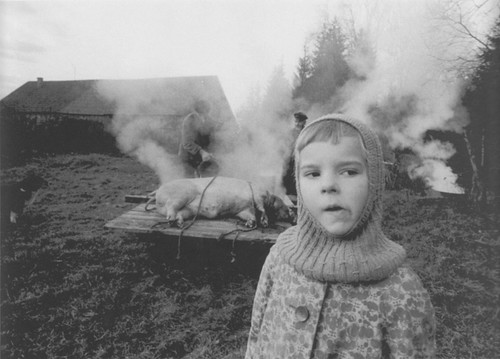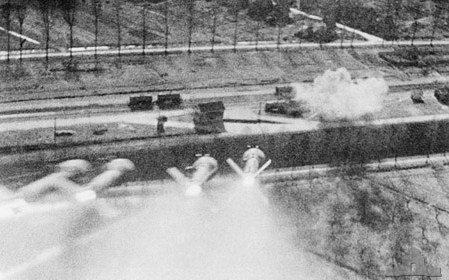
No contemporary rider has reinvented himself so effectively as big Thor Hushovd, the Bull of Grimstad.1 Starting as a time trial and classics specialist, he became a dominant sprinter, twice winning the green jersey and only missing the points classification podium once between 2004 and 2010. But with another, younger sprinter on his team in Tyler Farrar, and Mark Cavendish dominating from behind the best leadout team in the sport,2 Thor had ride for his team and pick his days to try to win stages. And goddamn but he did both.
1: If there were a jersey for best nickname, Thor would win it every year; if he crashed out, Fabian "Spartacus" Cancellara would take the honors.The second day of racing was the team time trial. Hushovd anchored the Garmin-Cervélo squad to victory, grabbing the yellow jersey. The next day, in yellow, he was the leadout man that let his American teammate Tyler Farrar take the win on the 4th of July. He managed to hold the maillot jaune for eight days, through the foothills of the Pyrenees. Hard to do more as a team rider.
2: In a lot of ways, Mark Cavendish is like Lance Armstrong, sprinting edition: he's a fantastic individual talent with unquestionably the best team and he's sort of a cock. Now, the general classification is far more dramatic and interesting than the points one, and Armstrong had both a stretch of dominance Cav hasn't touched and a ludicrously poignant backstory. I do wonder what it would have looked like had Gilbert committed fully to the points game this year over considerations of his overall time.
And for himself, he won another two stages, bringing his career total to an impressive 10. But while all his previous stage wins have come in the sprint finishes to flat stages, this year he won in the mountains. If you have the time, watch this from 5:47 through to the end. If not, the other important bits start at 8:50, and 14:35/16:26 (14:35-16:26 isn't strictly necessary, but at the time those two minutes provided some fantastic dramatic tension), and the finish line appears at 19:00:
After getting himself into a ten-man breakaway away from the elite climbers jockeying for overall position, Thor attacked very early in the hors-catégorie climb up the Col d'Aubisque. He climbed aggressively, but he's still a 180-pounder and at the summit French climbers David Moncoutié and Jeremy Roy were ahead of him by one and two full minutes, respectively. The long descent and flat finish played to Hushovd's strengths, but that's quite a gap to bridge solo.

Since this whole business was framed by a discussion of heroism, I'd be remiss not to discuss descending. While to climb is to embrace pain that increases geometrically the faster you go, to descend well is to court catastrophe. So far as I know, only one man has died on an ascent during the Tour de France; many have died on the way back down. Hairpin descents demand total concentration, flawless balance, and perfect judgement of speed and line. Even a momentary lapse can lead to the end of your career or a very real death. So when Thor was clocked at 112 kph (just shy of 70 mph), nearly 20 kph faster than anyone else took the Aubisque, it wasn't just a nice talking point: it was fucking bananas.

Halfway down, he had caught up Moncoutié. The two slowly reeled in Roy, but as he came into view, Moncoutié stopped helping: it was clear he couldn't take Hushovd at the line, and he wouldn't help finish off another Frenchman. The final 10k were a slow-motion mano-a-mano showdown between Roy and Hushovd, each too exhausted to put the hammer down, with Moncoutié waiting for an opening that never came.
Timing an attack in cycling is essentially brinksmanship. Setting out alone is draining, so you have to justify blowing all that precious energy by building enough of a gap to reach your goal before your legs give out and you get caught up. If that goal is an intermediary sprint or climb to pick up a few points towards the polka dots or green, you might slip away unmolested. But if it's the finish line, you never get that luxury. Every moment you wait, you give yourself a shorter distance to cover with your finite glycogen stores; every moment you wait, you risk an opponent making a move before you and forcing your hand. To time a long attack so well you arrive at the finish fresh enough to seal the win takes an unflinching calculation of your strengths and weaknesses compared to the field; a clear mapping of that calculus over the remaining topography of the day's race; a firm grasp of the politics of the riders around you and their (dis)incentives to team up with you in a break3; and most of all, faith in your legs. With every extra kilometer and every terrain feature on which you are at a disadvantage, your margin for error narrows. La tête et les jambs.

55.8 km after he launched himself from the head of the breakaway and 2.3 km before the finish, Thor dragged himself into Jeremy Roy's slipstream and made a move with everything his legs had left. Roy simply couldn't match the strength of Thor's sprinter's muscles in the final anaerobic kilometers. Crossing the finish line alone in the rainbow stripes of the World Champion was surely gratifying, but the ride that lead up to it? That was beautiful.

3: Any small group of riders ahead of the peloton works out like a version of The Prisoner's Dilemma with hierarchical alliances between any teammates and a set of incentives to cooperate and defect that is constantly in flux based on each rider's position on the road, position in the overall standings, and level of energy. It is the best thing the sport has to offer.

No comments:
Post a Comment